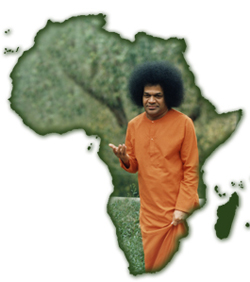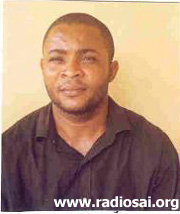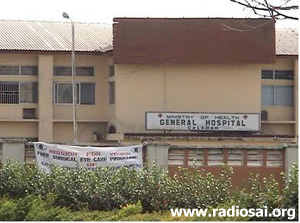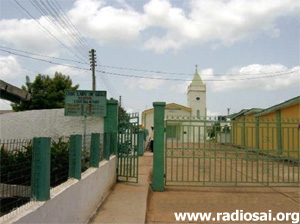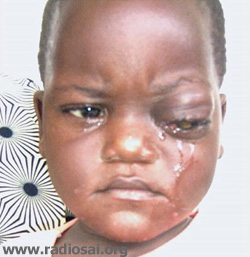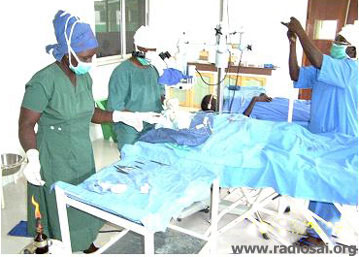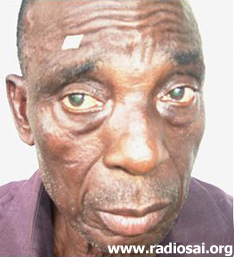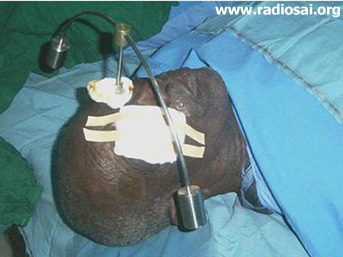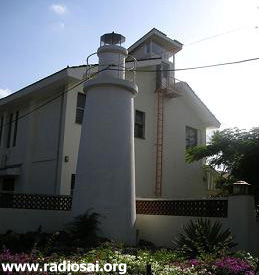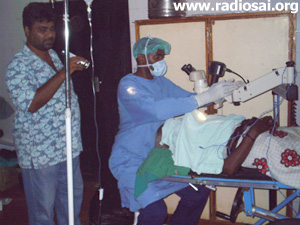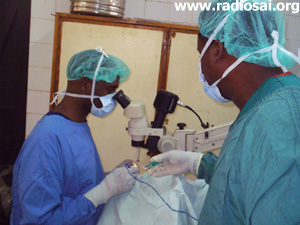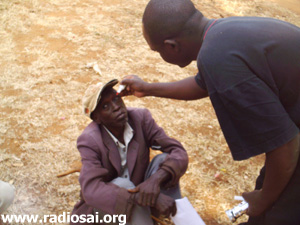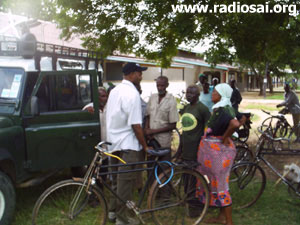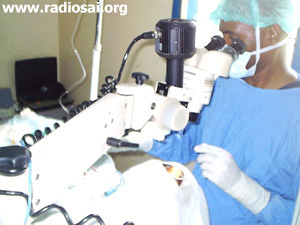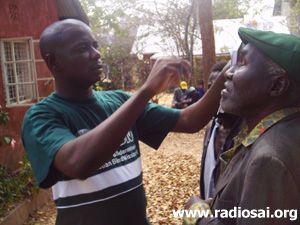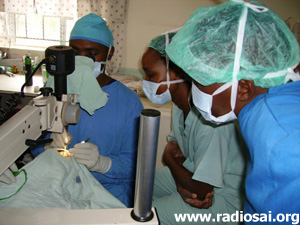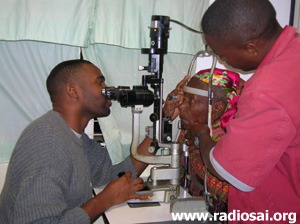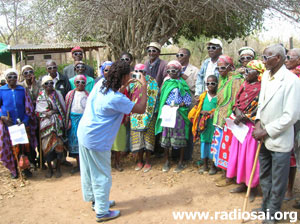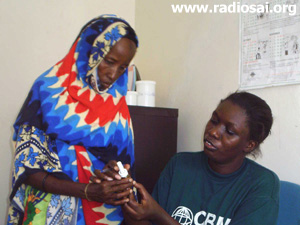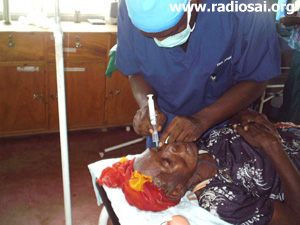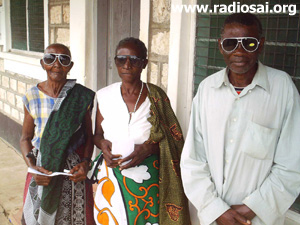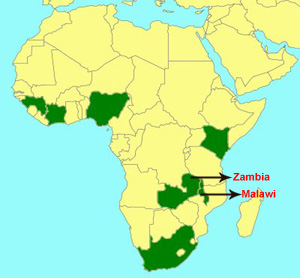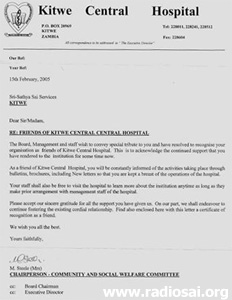SAI VISION FOR AFRICA
The eye affected by a cataract swears there is no lamp in the room - an operation to remove the cataract makes that eye aware of the lamp. That operation is the symbol of the spiritual discipline that one has to undergo, in order to have a Vision of God.
– Bhagawan Baba
To commemorate the 80th Birthday of Bhagavan Sri Sathya Sai Baba, devotees in Africa and from the United Kingdom started a Seva programme of medical eye camps in Africa for cataract surgeries in 2005.
Sai Vision For Africa
Swami blessed the programme on 25th November 2004 and instructed that the operations performed should be of the best quality, emphasizing that high quality and not the number of operations should be the goal. Swami explained that love and care should be shown to each and every patient. When service is motivated by love it is bound to succeed - and that success is ascribed to the grace of God.
The first surgery was preformed on Friday, 14th January 2005 (Makarsankranti) at Calabar, Nigeria. In Ghana, the surgeries started on 19th April 2005. Surgeries began in Kenya on 14th February and in Malawi from July 18th.
Many people in Africa suffer from cataract problems because they cannot afford the cost of surgery. Eventually they lose their eyesight and are left largely uncared for. It is for this reason that free cataract operations are the only way to alleviate the suffering of this neglected portion of the population living beneath the poverty line in the second most populous continent of the world after Asia. |
|
|
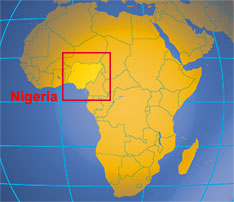
|
|
All the cataract surgeries were conducted with the cooperation of the ministry of health in each respective country, who were kept updated on the progress. The surgeons and hospitals used for these procedures were often recommended by the local authorities. Most of the surgeries were carried out in small towns and villages where there were poor and needy patients and the Sai Organisation in every country and region made provisions for post-operative care with the local hospitals in the area.
The medical coordinator for this project was Dr. S. Upadyay who visited some of the African countries to verify the quality of surgeries and the hygiene standards within the hospitals. Special attention was given to the lenses that were required and where such lenses were not available locally they were imported.
|
The press and radio carried information on when and where the surgeries were to be performed and patients came from various parts of the country and in some cases from neighboring countries. Now we take you through the Sai Vision Project that was successfully executed in six African nations, starting with Nigeria.
Sai Vision In Nigeria
Can you, dear reader, imagine the joy that Alice must be feeling! Alice is forty-five and has three sons and two daughters. She was diagnosed with developmental cataracts in both eyes and had been blind since the age of ten. She said:
|
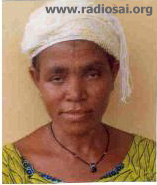 |
Prior to the surgeries I depended on the children and my husband within the household for every activity and house chores. This was quite frustrating, as I felt like a cripple as a result of my blindness. After I had both eyes operated on I began to do things myself and now I can even cook for my husband!
Alice is all smiles now. The operation actually came at the perfect time. As Alice explained:
|
Before the surgery |
...and after |
|
This was a difficult period for us all because my husband is the chief of the village and as he could not effectively perform his responsibilities he wanted to resign.
Now her husband does not need to resign and the family is full of joy!
Or consider the case of Edward, a thirty-two-year-old motor mechanic. After developing a cataract in his left eye he lost his job due to his blindness in 2002. Following the surgery, Edward expressed his feelings as follows:
I'm very well now and have good vision - I got back my employment….For the last two years before my operation I couldn't do my work. At that time it was very hard. I had to sell some of my personal possessions, including my house. My situation was very bad and my prospects looked bleak. I was unable to move on my own and kept bumping into people on the road….Now I start work at six every morning and am happy in my work. Back then I just cried on my own.
|
|
|
| |
Before |
After |
Imagine these two cases replicated thousands of times and you have a picture of the lifesaving effects of the Sai Vision Project in Africa, all inspired by Bhagavan’s Grace to work selflessly in creating a better world. A total of over 2,800 surgeries were performed in Nigeria, all at two hospitals, one in Kebbi and one in Calabar.
Before commencing, the surgeries were turned into a spiritual event with the recitation of Ashtotharashatha Namavali (108 Names of Baba), Aarti, distribution of Vibhuti, prayers from the Muslim faith, and pictures of Swami adorned with flowers and incense. All the patients, their relatives and the hospital staff were invited to attend the prayers. |
|
|
| |
|
Calabar General Hospital in Cross Rivers state, Nigeria |
Sai Vision In Ghana
|
|
On the advice of Dr. Marian Hagan of the National Eye Health Programme of the Ministry of Health of Ghana, surgeries began at Our Lady of Grace Catholic Hospital in Breman Asikuma on 19th April. The Sai Organisation publicized the free operations via posters, FM radio and newspaper adverts in Ghana’s capital Accra, and in the hospital’s locality. The hospital in the central region of Ghana was chosen as it covered remote rural areas and people from very poor backgrounds.
After the first group of patients was successfully operated on, word spread and people from other regions of Ghana and even neighboring countries came to avail themselves of the opportunity. Over the next four months more than 500 surgeries were performed. |
Our Lady of Grace Hospital, Ghana |
|
|
Surgeries were carried out on patients of all ages, from three-year-old Yaw Amoateng to ninety-two-year-old Mr. Kojo Arko.
|
|
|
| 3 Years old Yaw Amoateng |
|
Dr. Baah & Nurses |
|
|
|
| 92 Years old Mr. Kojo Arko |
|
Mr. Kojo Fodjour. |
Sai Vision In Kenya
Thanks to the dedicated Sai Volunteers of Mombasa Sai Centre in Kenya, more than nine eye camps were conducted between February and August 2005 restoring the gift of sight to over 500 people. But the unique aspect of this service was that all these camps were organized in very remote and rural areas of Kenya with Mombasa, the second largest city in Kenya, being the base.
With the help of local doctors from the Lighthouse for Christ Eye Centre, all these surgeries were conducted free of charge and with a great deal of love. The team traveled hundreds of kilometers over rough terrain and difficult roads to reach the eye camp sites and serve the poor rural folk. It was not service of convenience, but service of need. |
|
|
|
|
How the Outreach Programmes Worked
The modus operandi of the programmes was simple. Usually a team consisting of four to five persons, including a few support staff apart from a surgeon, would pack all the surgical and clinic supplies in a Land Rover and drive to the remote locations.
On reaching the village, the first two days would generally be taken up in doing a survey and then screening and identifying patients suitable for cataract surgery. Over the next two to three days, these patients would be operated on.
Four to seven days was the typical timeframe for these outreach programmes. All the patients were followed up after a week to review their status. |
Lighthouse for Christ Eye Centre, Kenya |
|
|
Various Challenges
Though it may sound simple, in the field there were obstacles and challenges galore! For example, it took more than seventeen hours for the five member staff to negotiate rough and unfriendly roads to reach the town of Kibwezi. And worse, the camp unfortunately coincided with a cholera outbreak in the region. The team conducted their surgeries only after addressing all the safety issues. Later, they arranged for the accommodation of the patients in a nearby St. Paul nursery school by requesting the help of the Catholic Diocese of Kibwezi. All this made possible the forty-five surgeries which would have otherwise been postponed or cancelled.
|
|
|
Kibwezi and Kambu Mobile Outreach Programme |
In fact, on one occasion due to frequent power failures, the dedicated team performed the operations by candlelight as there was no alternative source of light. But the most exciting fact to note is that all the surgeries were completed successfully and no patient had any complications. All the patients were given medication and advised to return in a week’s time for re-evaluation. The elation of the patients had to be seen to be believed. One sixty-five-year-old lady, who lost her vision two years ago, started dancing with joy when she found she could see again!
More Hurdles in Mwingi, Lamu and Isovya
If the way to Kibwezi was challenging, the team now had to travel approximately 550 kms northwest of Mombasa through regions where there were no roads at all and daunting terrain to access Mwingi. But for the 4-wheel drive Land Rover they could have never managed the journey.
|
|
|
At the Mwingi Medical Outreach Programme |
To reach out to the Kenyan island of Lamu, the team drove 360 kms along the coastal border to Mpeketoni and then went by boat to cross the sea. Like many others, this route was by no means considered safe. Apart from the endless bumps, potholes, twists and turns, it was notorious for banditry attacks (allegedly launched from Somalia).
|
|
|
Mpeketoni – Lamu (Faza) Mobile Medical Outreach Programme, June 2005 |
Likewise, to reach Isovya in Kitwe district, the team faced a grueling 600 km long trip. Full of treacherous roads, they reached their destination tired and worn out. The next day they awoke early in the morning to find patients already waiting and a busy day ahead of them. The turnout was an encouraging sight and the team conducted eighty-four surgeries over three days. Though taxing and demanding, it was also a deeply rewarding experience.
|
|
|
Isovya Medical Outreach Programme, August 2005 |
In many of these outreach programmes, some people did not come forward for the operation out of fear and apprehensions, but once they saw others being benefited and heard good reports, they too asked for the surgery.
In Witu division of Lamu, many patients who were screened and identified for surgery did not come for their operation as they did could not leave their farms unguarded from…baboons! The crop was their bread and butter and they opted to stay and protect what little they had. Such is the state of these poor folk and the difficult choices that must be made in the name of basic survival.
|
|
Another sad story was that of a young boy who had cancer of the eye and had to have it removed. Six to twelve months before the camp, his parents were advised to go to a hospital in Mombasa to get the affected eye taken out. Delay meant a greater likelihood of the cancer spreading further, but the parents could not afford it and so let it be. When the team discovered this, they immediately enucleated the eyeball before it was too late. Though the damaged eye could not be restored, there was relief in saving the child’s life. The parents had no words to express their appreciation and gratitude and the team of doctors and other support staff were also deeply moved.
In most of these impoverished areas, the volunteers not only screened and operated on hundreds of patients they also distributed a lot of other essential items. In Mwingi, for example, clothes were given away to needy patients and hungry children, who had almost nothing to protect them from the cold weather, received warm clothes as well as nourishing food.
|
The above narration is a very brief account of the tremendous seva going on in this small African country of Kenya . To give you a complete glimpse of the Sai Vision Project in Kenya , here is a table with the actual figures. One point to note is that if, for example, at Kibwezi forty-five surgeries were done, it does not mean forty-five patients were seen. In reality hundreds were seen and given free consultation and only forty-five were found to be suitable candidates for cataract surgery and were operated upon. So the patients reached are far more than the number of surgeries done.
Schedule of Medical Outhreach Programmes in Kenya |
Date of camp |
Area it was conducted |
No. of Surgeries |
| 14th – 18th Feb 2005 |
Garsen & Wema & Others at LCEC
|
45 & 20
|
| 14th – 18th Mar 2005 |
Kibwezi & Kambu & Others at LCEC
|
45 & 18
|
| 29th Mar – 1st Apr 2005 |
Marafa & Garashi |
63
|
| 10th Apr – 15th Apr 2005 |
Ngao – Tarasaa |
25
|
| 28th May 2005 |
Mombasa Bombolulu |
32
|
| 12th – 17th June 2005 |
Mpeketoni – Lamu |
10 |
| 25th June – 1st July 2005 |
Witu – Kipini & Others at LCEC
|
17 & 08
|
| 17th – 24th July 2005 |
Mwingi, Kaloleni, Kilifi & Others at LCEC
|
108 & 06
|
| 7th – 14th Aug 2005 |
Isovya, Vipingo & Matsangoni |
107 |
|
503 Surgeries
|
As already mentioned, Mombasa was the base of all the outreach programmes and the devotees and Bal Vikas children of Mombasa Sai Centre enthusiastically came forward to lend their support in quite a few of these camps, for example, serving hot food to the patients in the Bombolulu camp. However, more important than this is the transformation these camps brought about in the devotees and the children. It was a great opportunity to serve and an amazing and heartfelt spiritual experience.
|
|
|
Wema Medical Outreach Programme |
One of the Bal Vikas children wrote of his experience:
I feel so happy to serve needy people. But I am sad I am unable to help so many others who need help and are not within my reach.
This is the most beautiful aspect of the unique service project in Africa. It gave clarity of vision not only to the cataract affected patients but also to everyone else associated with it. It sensitized people and principally the younger generation to feel for their neighbours and reach out to the impoverished and needy, selflessly and silently.
Sai Vision In Malawi
Now moving on from Kenya, during the first two camps held in Malawi a total of 3343 patients were screened and 212 patients identified for cataract surgery and operated on. Binocular lenses were inserted in 210 of them. Devotees also did Narayan Seva (serving food) during camps. In five camps conducted between July and November 2005, devotees reached their target of 500 cataract operations as their offering to Bhagawan on the 80th year of His advent. It was 516 cataract operations to be precise and a total of 5297 patients were examined.
Sai Vision In Zambia
In Zambia, Sai devotees organized the Cataract Medical Eye Camp for Cataract Surgeries in Kitwe, the third largest city in Zambia. More than 100 were treated with the support of the Kitwe Central Hospital.
All of these surgeries were done in the Kenyan-fashion – reaching out to the rural folk through outreach programmes. These were patients who had neither the facility nor the money to get their sight back and all were extremely grateful.
The devotees also organized a review of these patients in nearby hospitals and provided reading spectacles free of charge.
In recognition of their service, the Sri Sathya Sai Organization of Zambia was invited to join the Kitwe Central Hospital in celebrating World Vision Day on 13th October 2005. |
|
|
Letter of appreciation and certificate of recognition from Kitwe Central Hospital , Zambia.
|
|
|
Certificate of Recognition by Kitwe Central Hospital, Zambia |
|
Appreciation Letter |
Sai Vision In South Africa
|
|
The Sai Vision Project reached all the way to the bottom of the continent – South Africa. On the 16th and 17th of July 2005, twenty-one cataract surgeries were performed at the Catherine Booth Hospital supported by a team of two ophthalmic surgeons and two ophthalmic nurses, who were impressed with the voluntary service programme and graciously agreed to be part of the team. In fact, they also assisted the project by obtaining important equipment (such as microscopes) that was necessary for the operations.
When the twenty-one recipients removed the bandages on the day after the operations, the surgeons were moved to tears at seeing the delight in their faces. It was truly a life-altering experience for the patients who exclaimed their joy and were unable to contain themselves. In receiving new vision, they had been given a new life. |
Earlier on 3rd July 2005, Sai devotees of South Africa had conducted a dental camp at the same Catherine Booth Hospital which was also well received. More than 165 persons were treated and 145 dental extractions performed.
Over the last five years, the amount of seva done in this often neglected part of the world has been amazing. More than 4500 cataract surgeries have been done in six African nations and it is still going on. Ask the volunteers how they feel about it and they will say as great as the benefits are to the patients, they are the ones who have gained the most. The Sai Vision project has truly been an eye-opener for them. It has taught them to look at the other person in a new light…and has softened their hearts and taken them closer to Baba.
At Heart2Heart we are very pleased to bring to you these inspiring accounts. There is a lot more happening in Africa. There are leprosy homes, the mammoth “Sainet” project of providing specially-treated mosquito nets, rural service camps, and other medical camps, etc. In the coming issues we hope to bring you updated information and more moving stories of love and Sai-inspired service.
We are grateful to Mr. Kishen Khubchandani and many other Sai devotees (whom we do not know personally) from Africa who helped us in the making of this article.
– Heart2Heart Team




